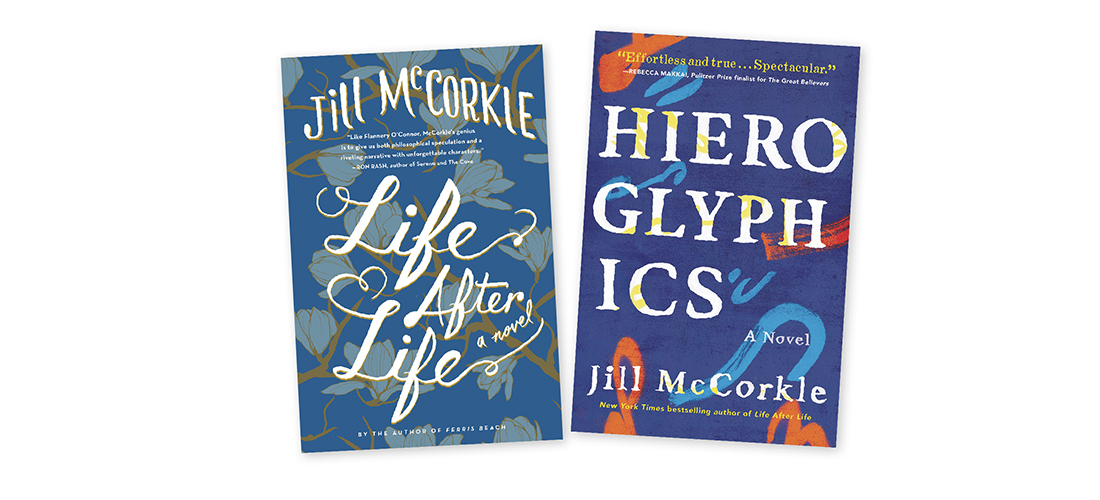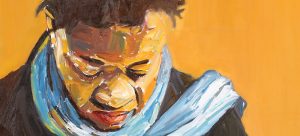
A McCorkle Couplet
Connecting tissue of two novels
By D.G. Martin
In 1984, a young North Carolina writer, Jill McCorkle, shocked the literary world by making her debut with two simultaneously released novels, The Cheer Leader and July 7th. The New York Times called her a born novelist. She went on to write three more novels, Tending to Virginia (1987), Ferris Beach (1990), and Carolina Moon (1996).
Then she paused to concentrate on short stories that won high praise. But in 2013 she was back with another novel, Life After Life, and then again in July 2020 with Hieroglyphics. Both books deal with the complications in older people as they face life’s end.
Life After Life focuses on residents of a retirement home and the people who work for and with them. Hieroglyphics deals with one couple’s efforts to adjust to retirement and aging. Into these settings McCorkle injects rich and disturbing stories that hold her readers’ attention throughout.
Life After Life is set in the fictional town of Fulton, North Carolina, a place not unlike Lumberton, where McCorkle grew up. In the Pine Haven Retirement Center, her characters come together as residents, staff, visitors and family.
One important character, Joanna, provides hospice-like counseling and comfort to dying residents and their loved ones. Her activities give the novel a gentle storyline and provide a persistent reminder that illness and death are an inescapable part of the experience at Pine Haven.
A mentor tells Joanna, “Make their exits as gentle and loving as possible. Tell them how good it will be, even if you don’t believe it yourself. You’re Southern, you know how to do that.”
McCorkle describes how family members embrace Joanna “like she is one of them. Lung. Brain. Breast. Uterus. Pancreas. Bone. The families discuss and explain their loved one’s symptoms and diagnoses for her as if they have never been heard of before, have never happened to anyone else, and she listens.”
Each of McCorkle’s characters has a different set of challenges, but the onset of fatal illness and death is a constant.
For instance, there is Stanley, a lawyer and widower. After Stanley’s wife died, his son moved into the family home, would not leave Stanley alone, slept beside him in his dead wife’s place in their bed, and began driving the grieving father crazy.
To get away from his son, Stanley decided to act as if he really was crazy and therefore needed to be in a retirement center. He constructed a new image for himself, a kind of senility combined with a loss of judgment that led to inappropriate remarks to women. His crude descriptions of his desires and how he wants to fulfill them prove that his mental condition requires institutionalization. Stanley’s crazy conduct is an act to get him away from his son and into the retirement center. It worked.
Stanley is only one of the several characters whose situations evoke sympathy, pain and laughter.
Dealing with the presence of death is part of life’s experience. Reading Life After Life deepens a reader’s realization of its oncoming approach. It makes one wonder again why we are here, why we are still here, and whether there really is some life after life.
At the end of Life After Life, one of Pine Haven’s most popular service people, C. J. (for Carolina Jasmine), is found dead in her apartment. It looks like suicide, but there are hints that something is amiss. A single parent with a young son, C.J. had been secretly seeing a surgeon who had a wife and other love interests. The surgeon is an obvious suspect, but there is no closure to his fate.
Near the book’s ending another character remembers “a train wreck in this very county in 1943 where over 70 people died, most of them soldiers trying to get home for Christmas.” McCorkle says she recalls her dad talking about visiting the crash site near Lumberton and seeing all the scattered debris.
C. J.’s death and the train wreck provide connective links from Life After Life to Hieroglyphics. The father of a central character in Hieroglyphics died in the train wreck.
McCorkle also lived in Boston for a number of years, where she heard about a 1942 nightclub fire that took more than 492 lives, including the mother of another key character in Hieroglyphics.
When Lil, whose mother died in the fire, and Frank, whose father died in the train wreck, first met, they discovered their common bond, one that held them through 60 years of marriage.
The story begins with Frank and Lil, now in their 80s, retiring to Southern Pines. They live within driving distance of the train wreck’s site, which is near the modest home where Frank lived for several years after his dad’s death.
Frank and Lil have driven to the old house, now occupied by Shelley, a single mother, and her young son, Harvey. Shelley has seen Frank driving by before and is nervous. “It doesn’t help that that old man rides by so often now, his green Toyota slowing in front of the house and then circling the block.”
When Shelley meets Frank at the door, he explains, “I grew up here. I would love to see inside if convenient. My wife, too.”
Shelley resists, but at the end of the book Frank is in the backyard of the old house finding some closure.
In the 300 pages between its opening and closing at the old house, McCorkle takes us deep into the lives of the characters we meet on the first pages: Frank, Lil, Shelley and Harvey.
Frank carries the consequences of the train wreck throughout his life. Both his father and mother were on the train, coming from Florida to their home in Massachusetts, where Frank and his grandmother waited for them. Frank’s seriously injured mother remained in North Carolina to recuperate. She was sure she heard Frank’s father calling, “Don’t leave me.” So she stayed and ultimately married a local man.
Frank joined her and they lived in her new husband’s house. Ultimately, Frank went to college and graduate school, married Lil, and became a college professor specializing in ancient history and archeological relics. Along the railroad tracks he collected relics from the wreck, including a toy decoder that he imagined his parents were bringing him for Christmas.
Lil cannot get over the loss of her mother, a ballroom dance instructor, who had not told her husband or Lil that she was going to the nightclub. The questions of who her mother was with and why still haunt Lil. She is also a collector. McCorkle uses Lil’s collected newspaper clippings and copious notes to help tell a story that include her agonizing experience of Frank’s misadventures with a younger academic.
Shelley’s son, Harvey, collects horror stories about the Beast of Bladenboro, the Glencoe Munchkins, and other scary tales that keep him awake at night and that he uses to frighten his schoolmates and add complication to his mother’s life.
Shelley is a court reporter in a Robeson County courtroom during a high profile trial of the doctor accused of murdering one of his many girlfriends. The doctor’s victim was C.J., a major character in Life After Life.
Shelley’s troubles with Harvey and Frank intersect with her life’s other challenges to put her court reporter’s job at risk.
McCorkle brings these different characters together into a complex, layered and gripping novel, making Hieroglyphics, along with Life After Life, more proof of her storytelling genius. OH
D.G. Martin hosts North Carolina Bookwatch Sunday at 3:30 p.m. and Tuesday at 5 p.m. on UNC-TV.





